In this section, we are going to understand Database testing, which checks the schema, tables, triggers, etc. of the database under test.
And we also learn about following concept of database Testing:
- Why we need to use database Testing
- Database testing process
- Types of database testing
- How to perform database testing manually and with the help of automation tool
- What are the different challenges we may face during the database testing?
- Components of database testing.
Before we discuss database testing, firstly, we will understand the definition database.
What is a Database?
A database is a prearranged collection of data containing the information and helps in data manipulation. A database can easily manage and retrieved by the user. We can establish data into tables, rows, columns, and indexes, making it easier to identify the appropriate data.
In a Database, data management becomes a very easy task because we can use the databases as databases to retrieve the information like tables for storing data, function, triggers for data manipulation and view for data representations.
Note: The Database is become more difficult over time due to the massive amount of data stored in a software system.
After understanding the database concept, we have now come to our main discussion on database testing.
Introduction of Database Testing
In software testing, Database Testing is testing, which is used to analyze the schema, tables, triggers, etc., of the database under test. It also assesses data integrity and consistency, which might include creating difficult queries to load and stress test the Database and review its responsiveness.
Generally, it contains the layered process, which involves the data access, User Interface [UI], the business layer, along with the database layer.
During the database testing, we can cover the following database activities, such as:
- Testing data integrity
- Checking data validity
- Performance check relate
- Triggers and Functions in the database
- Testing various procedures
Why do we need to perform database testing?
If we performed the database testing, it would ensure the database's efficiency, maximum stability, performance, and security.
And these features can be set aside on a check occasionally to confirm that the software application is stable as soon as deployed in a competitive environment. To perform database testing, we must have a basic knowledge of SQL.
To get more information about the SQL, we can refer to the following link: https://www.javatpoint.com/sql-tutorial
What is the purpose of the Database Testing?
The main objective of performing database testing is to make sure they follow the various aspects:
- Transaction's ACID Properties
- Data mapping
- Accuracy of Business Rule
- Data integrity
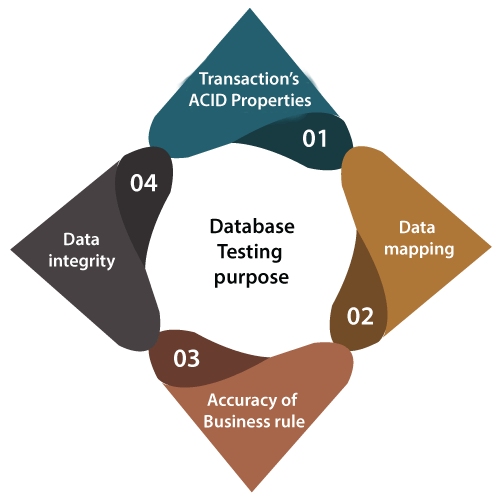
1. Transaction's ACID Properties
The database testing will ensure the ACID properties of the transaction.
A Database performs these four ACID properties. The ACID properties are as follows:
- Atomicity
- Consistency
- Isolation
- Durability
Atomicity
- The term atomicity in transaction specifics that the data remains atomic, which implies that if any operation is performed on the data, it should be performed or implemented entirely or should not be implemented at all.
- It is also known as All-or-Nothing.
Consistency
- The term consistency specifies that the value should remain always preserved after the transaction is completed in the transaction.
- And the integrity of the data is very important therefore, the database remains consistent before and after the transaction. The data should always be correct.
Isolation
- In the transaction, the term isolation means separation, which specified that the multiple transactions could implement all at once without impacting one another and changing the database state.
- Or if two or more transactions occur concurrently, the consistency should remain preserved.
Durability
- The word durability makes sure the permanency of something, which further implies if a transaction is committed, it will keep the modifications without any fail irrespective of the effect of external factors.
- And the durability of the data should be so faultless even though the system fails, the database still survives.
2. Data Mapping
Data mapping is an essential feature in database testing, which is mainly focused on verifying the data that pass through back and out between the application and the backend database.
Below are some of the important features tested in the data mapping:
- We analyze whether the user interface or front-end methods are mapped constantly with the equivalent fields in the database table.
- Characteristically, this mapping information is specified in the requirements documents.
- When a specific action is done at the front-end of an application, an equivalent Create, Retrieve, Update and Delete [CRUD] activity gets used at the back-end.
- And then, the test engineer will have to assess if the correct activity is used and whether the user action in itself is effective or not.
3. The Accuracy of the Business Rules
- Database testing ensures the accuracy of the business rules as we know that complex databases lead to complex components such as stored procedure triggers and relational constraints.
- Therefore, the test engineer will come up with appropriate SQL commands to verify the complex objects.
4. Data Integrity
- The database testing also makes sure the data integrity, where we can update, and the most recent shared data values should appear on all the forms and screens.
- And if the value should not be modified on one screen and show an older value on another, then the status can be updated concurrently.
How to perform Database Testing
We can perform the database testing either manually or with the help of some automation tools.
How to perform database testing manually
To perform database testing manually, which need to follow the below process:
- Firstly, we will Open the SQL server in our local system.
- After that, we will open the query analyzer to write the command and retrieve the data.
- Once we can retrieve the specified data, we will compare the detailed data with the expected result.
- Then we can update or delete the data to check how the software application performs.
- The general test process of the testing database is not dissimilar from any other application. Therefore, to run the test, we can follow the below steps:
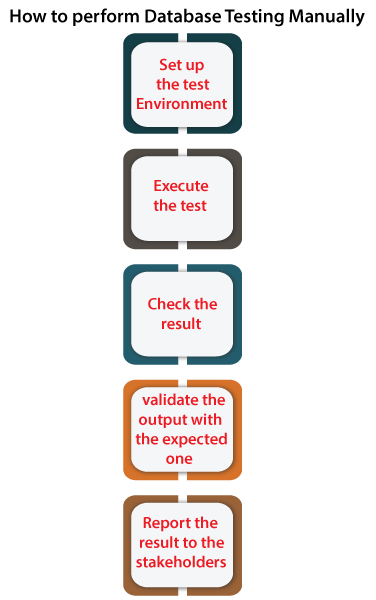
Step1: Set up the test environment
Firstly, we need to prepare the test environment to test the software application.
Step2: Execute the test
Once we set up the test environment, we will run particular test case.
Step3: Check the results
When the test case is executed successfully without having any issues, we will check the specified test case results.
Step4: Validate the output with the expected one
After checking the test case result, we will validate the same output with the excepted one. If the results meet the excepted output, the test case will consider as a pass; otherwise, it will be marked as a fail.
Step5: Report the results to the stakeholders
And at last, we will report the results to the stakeholder of the particular software application.
Note: If we set-up the environment, the test engineer and developers will develop all possible scenarios, which can execute through the application.
Then, the test will involve running through these queries and checking the data integrity, which means that the resulting data will need to be truthful, accurate, complete, retrievable, and verifiable.
And the test could also include monitoring data mapping, the different ACID properties, and ensuring the implemented business rules' accuracy.
How automation can help in Database Testing
In software testing, Automation testing is used to decrease the repetitive manual work, which helps the test engineer focus more on critical features, which work the same for the database testing.
Let's see a few scenarios where automation can be very useful for the test engineer:
- Modification in the database schema
When every schema is modified, the database needs in-depth testing to ensure that the things are in place. And the number of scenarios to be covered based on the size of the database. And this process is time-consuming if we have done it manually.
- Monitoring for data integrity issues
There can be a condition where a set of data gets corrupted in recovery or other actions because of human error or other issues.
But if we consider the automated monitoring processes, it became easier to find those variations, and we can fix them as soon as possible.
- New or frequently altering applications
As we know that Agile methodology is the new era of testing, where we will have a new release to production at the end of every sprint, which implies it will take every 2-3 weeks to complete one round of testing.
But with the help of automation features, which is completely constant and unchanged in the recent sprint, we can focus on new modified requirements.
Database testing components
Following are the components of the database testing:
- Database schema
- Transactions
- Store procedure
- Field constraints
- Triggers
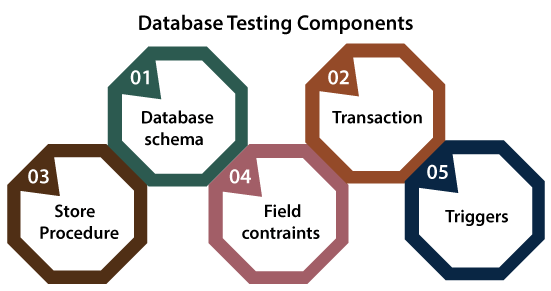
1. Database Schema
A database schema is used to describe the working of data in a Database and its organization. In other words, we can say that it is nothing but a proper classification of how the data will be planned inside the database.
For testing those conditions, we have two ways, which are explained below:
One of the Below approaches can be used as per the tool's significance:
- We can use the SchemaCrawler tool, which is a free database schema discovery and comprehension tool.
- Regular expressions are a good approach to verify the names of the specific fields and their values.
- To verify the schema, we can use the following SQL command:
Find the needs according to the Database operates
- The Field names begin or end with explicit characters.
- The Primary keys need to be generated before any other fields are designed.
- The specific values can or cannot be inserted in the fields that have a constraint.
- For easy recovery and search, the Foreign keys must be indexed completely.
2. Transactions
One of the most important database testing components is transactions because while we are performing the database testing, the ACID properties need to satisfy.
- The most commonly used statements are as below:
- To make sure the database remains in a consistent state, we can use the below ROLLBACK commands:
- To ensure the modification have been reproduced, we can use a SELECT command after the implementation of the above command:
Note: In the above statement, the Transaction table is the table that includes the transaction.
3. Stored Procedure
The Stored Procedures are relatively parallel to user-defined functions. And the entire system works in looming with the most consistent and correct result.
It can be used by Execute or Call Procedure commands, and generally, the output is in the format of result sets. The stored procedure system is used for multiple applications where data is kept in RDBMS.
We can test the stored procedure throughout the white-box and black-box testing.
- White box testing: In white box testing, the Stubs are used to invoke the stored procedures and then the output is verified in contradiction of the expected values.
- Black box testing: In this, we can operate the application's front-end (UI). And also assess the implementation of the stored procedure and its outputs.
4. Field Constraints
The next database testing components are Field Constraints, where the entire system works on the default value, exclusive value, and foreign key.
In this, we can easily verify the outcomes retrieved from the SQL commands, and
to ensure that the object condition in the database is implemented, we can perform the Front-end (user interface) operations.
5. Triggers
The trigger components are used to implement an entire table independently to record the output. In other words, we can say that a trigger (a piece of code) can be auto-instructed to be performed if a particular event takes place on a precise table.
Let us see one sample example, where we can understand the working of trigger components in the database testing:
- Suppose a new employee joined a company. And the employee is doing two tasks, which are development and testing. Then the employee is added to the Employee table.
- Once he/she is added to the Employee table, a Trigger could add the employee to the equivalent task's
- After that, we can follow the common process to test it, firstly the SQL command implanted in the Trigger independently and then it records the result.
- In the end, we can follow this process to perform the trigger as an entire system and then compare the outcomes.
These types of tests are completed in two ways, which are as follows
- White-Box Testing
- Black-Box Testing
Both the white-box and black-box testing have their procedure and sets of rules, which help us get the precise result.
Types of Database Testing
The database testing classified into three different types of testing, which are as follows:
- Structural testing
- Functional testing
- Non-functional testing
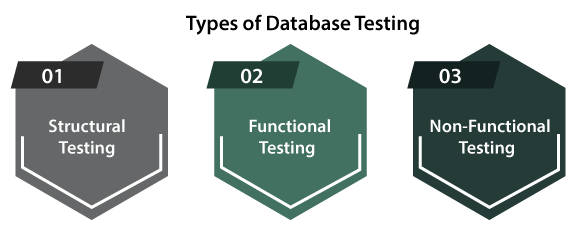
Let understand each type one by one:
Structural Database Testing
- It is a most important database testing technique used to verify all the elements inside the data repository, which are primarily used for data storage and not allowed to be directly operated by end-users.
- If we want a successful conclusion of this testing, we must have a complete understanding of SQL commands.
- In structural database testing, we can test the database components that are not visible to users.
- The structural database testing is mostly vitally used to validate the database.
Functional Database Testing
- The most important database testing approach is functional database testing, which is used to authorize a database's functional requirements from the end user's interpretation.
- The functional database testing's primary purpose is to test whether the end-user's transactions and operations are connected to the database work as expected or not.
Non-functional Testing
In the topic of database testing, Non-functional testing can be divided into several types as vital by the business requirements.
Some of the important parts of non-functional testing are listed below:
- Load testing
- Stress Testing
- Security Testing
- Usability Testing
- Compatibility Testing
Note: The load testing and the stress testing come under Performance Testing, which helps two specific non-functional testing objectives.
What are the different challenges of Database Testing?
While performing database testing, we may encounter the following challenges.
In the below table, we listed some common challenges and their
solutions:
|
Different challenges |
Solutions |
|
Testing huge data and production simulated the database |
|
|
Re-usability of data again for testing and Test data creation |
|
|
Separation of data and queries |
|
|
Cost and time were taken to get the data from a massive
database |
|
|
Frequently altering the database structure |
|
|
Unwanted data modification |
|
Misconception or Myths
related to Database Testing
When we are performing the database testing, we may undergo some
misconceptions about database testing.
Let us see them one by one and also understand the reality of
the related myths:
|
Misconception or Myths |
Reality |
|
The overall development process will slow down because of the
database testing. |
For this particular
myth, the reality is that database testing helps us enhance the database
application's overall quality. |
|
Database Testing is a monotonous job, and it involves plenty
of expertise. |
In software testing,
database testing is an efficient process, which gives long-term functional
stability to the entire application. |
|
Database testing is an expensive process. |
Expenses on Database
Testing is needed because any expenses on database testing is a long-term
investment that leads to long-term robustness and constancy of the
application. |
|
Database testing increases additional work for bottlenecks. |
In reverse,
identifying the hidden defects with the help of database testing enhances
more value to the overall work. |
Automation tools used
in database testing
- Data factory
- SQL test
- Mockup data
- MS SQL Server
- DbUnit
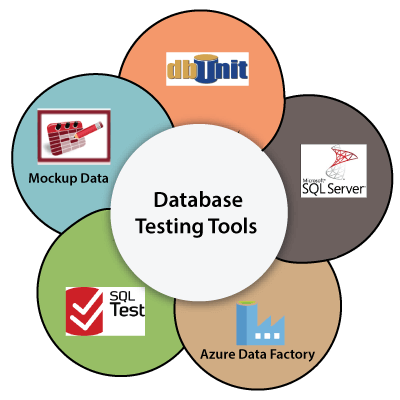
Data Factory

- The data factory is one of the most popular tools used for database testing.
- Mostly it is used for commercial database testing tools, which means that the huge project can be tested by a data factory tool.
- It works as a data generator and data manager in the context of database testing.
- For handling the complex command with a large amount of data, it is the most efficient tool.
- This tool gives us a platform to easily perform the stress or load testing on the database.
SQL Test

- The SQL test is the most frequently used Database testing tool available in the market.
- It is an open-source tool tSQLt framework, which means that it can be used by all the Database test engineer at least once.
- It allows us to execute the unit tests for SQL Server databases.
- With the help of this tool, we can easily execute extensive SQL tests.
- The major drawback of this tool is that it is slow compared to the other Database testing tools in the market.
Mockup data

- The Mockup Data testing tool also comes under the Test Data Generator category, and it is commercial testing tool.
- In this tool, we need to add columns in our table to validate the outputs.
- It helps us to create a huge Amount of Data, CSV files and databases with accurate data.
- It rapidly creates a large amount of data and tests several tables for a relationship with foreign keys.
MS SQL Server

- The Microsoft SQL server tool is extensively used to execute the unit testing.
- It is a commercial tool where we can generate in VB or C# projects, and the test engineer is expected to understand the project schema before starting the test.
- Even though we are creating the tests from a database project, we can use SQL Server Object Explorer.
- The main disadvantage of this tool is that it does not have any good user interface.
DbUnit

- It is an open-source tool, which is also known as the JUnit extension.
- It helps us export and import data into a database to and from XML datasets and work on large databases.
- It performs the CLEAN-INSERT operation initially; that's why it does not perform any further clean-up.
- With the DBUnit tool's help, we can explore the data and connect relational and multidimensional databases.
Conclusion
In the Database testing section, we have learned the following topics:
- Database Testing is testing, which is used to analyze the schema, tables, triggers, etc., of the database under test.
- To understand the database testing process's key concepts, the database test engineer must be aware of database testing's various features, types, manual and automation processes, and database testing tools.
- With this tutorial's help, we get to know about the misconception or their solution of database testing.



0 Comments